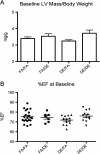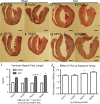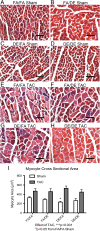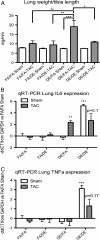In utero and early life exposure to diesel exhaust air pollution increases adult susceptibility to heart failure in mice
- PMID: 24279743
- PMCID: PMC3902482
- DOI: 10.1186/1743-8977-10-59
In utero and early life exposure to diesel exhaust air pollution increases adult susceptibility to heart failure in mice
Abstract
Background: Fine particulate air pollution (PM2.5) is a global health concern, as exposure to PM2.5 has consistently been found to be associated with increased cardiovascular morbidity and mortality. Although adult exposure to traffic related PM2.5, which is largely derived from diesel exhaust (DE), has been associated with increased cardiac hypertrophy, there are limited investigations into the potential effect of in utero and early life exposure on adult susceptibility to heart disease. In this study, we investigate the effect of in utero and early life exposure to DE on adult susceptibility to heart failure.
Methods: Female C57BL/6 J mice were exposed to either filtered air (FA) or DE for 3 weeks (≈ 300 μg/m3 PM2.5 for 6 hours/day, 5 days/week) and then introduced to male breeders for timed matings. Female mice were exposed to either FA or DE throughout pregnancy and until offspring were 3 weeks of age. Offspring were then transferred to either FA or DE for an additional 8 weeks of exposure. At 12 weeks of age, male offspring underwent a baseline echocardiographic assessment, followed by a sham or transverse aortic constriction (TAC) surgery to induce pressure overload. Following sacrifice three weeks post surgery, ventricles were processed for histology to assess myocardial fibrosis and individual cardiomyocyte hypertrophy. mRNA from lung tissue was isolated to measure expression of inflammatory cytokines IL6 and TNFα.
Results: We observed that mice exposed to DE during in utero and early life development have significantly increased susceptibility to cardiac hypertrophy, systolic failure, myocardial fibrosis, and pulmonary congestion following TAC surgery compared to FA control, or adult DE exposed mice. In utero and early life DE exposure also strongly modified the inflammatory cytokine response in the adult lung.
Conclusions: We conclude that exposure to diesel exhaust air pollution during in utero and early life development in mice increases adult susceptibility to heart failure. The results of this study may imply that the effects of air pollution on cardiovascular disease in human populations may be strongly mediated through a 'fetal origins' of adult disease pathway. Further investigations on this potential pathway of disease are warranted.
Figures








Similar articles
-
Neonatal Diesel Exhaust Particulate Exposure Does Not Predispose Mice to Adult Cardiac Hypertrophy or Heart Failure.Int J Environ Res Public Health. 2016 Nov 24;13(12):1178. doi: 10.3390/ijerph13121178. Int J Environ Res Public Health. 2016. PMID: 27886143 Free PMC article.
-
In utero exposure to diesel exhaust air pollution promotes adverse intrauterine conditions, resulting in weight gain, altered blood pressure, and increased susceptibility to heart failure in adult mice.PLoS One. 2014 Feb 12;9(2):e88582. doi: 10.1371/journal.pone.0088582. eCollection 2014. PLoS One. 2014. PMID: 24533117 Free PMC article.
-
Inhalation of diesel exhaust does not exacerbate cardiac hypertrophy or heart failure in two mouse models of cardiac hypertrophy.Part Fibre Toxicol. 2013 Oct 5;10:49. doi: 10.1186/1743-8977-10-49. Part Fibre Toxicol. 2013. PMID: 24093778 Free PMC article.
-
In utero exposure to diesel exhaust particulates is associated with an altered cardiac transcriptional response to transverse aortic constriction and altered DNA methylation.FASEB J. 2017 Nov;31(11):4935-4945. doi: 10.1096/fj.201700032R. Epub 2017 Jul 27. FASEB J. 2017. PMID: 28751527 Free PMC article.
-
Endocrine-disrupting activity of chemicals in diesel exhaust and diesel exhaust particles.Environ Sci. 2004;11(1):33-45. Environ Sci. 2004. PMID: 15746887 Review.
Cited by
-
Environmental pollutants and atherosclerosis: Epigenetic mechanisms linking genetic risk and disease.Atherosclerosis. 2025 May;404:119131. doi: 10.1016/j.atherosclerosis.2025.119131. Epub 2025 Feb 15. Atherosclerosis. 2025. PMID: 39986958 Review.
-
Association between particulate matter air pollution and heart attacks in San Diego County.J Air Waste Manag Assoc. 2021 Dec;71(12):1585-1594. doi: 10.1080/10962247.2021.1994053. Epub 2021 Nov 9. J Air Waste Manag Assoc. 2021. PMID: 34652980 Free PMC article.
-
Air Pollution and Cardiac Diseases: A Review of Experimental Studies.Dose Response. 2023 Nov 4;21(4):15593258231212793. doi: 10.1177/15593258231212793. eCollection 2023 Oct-Dec. Dose Response. 2023. PMID: 37933269 Free PMC article. Review.
-
In utero exposure to diesel exhaust is associated with alterations in neonatal cardiomyocyte transcription, DNA methylation and metabolic perturbation.Part Fibre Toxicol. 2019 Apr 11;16(1):17. doi: 10.1186/s12989-019-0301-9. Part Fibre Toxicol. 2019. PMID: 30975218 Free PMC article.
-
Neonatal Diesel Exhaust Particulate Exposure Does Not Predispose Mice to Adult Cardiac Hypertrophy or Heart Failure.Int J Environ Res Public Health. 2016 Nov 24;13(12):1178. doi: 10.3390/ijerph13121178. Int J Environ Res Public Health. 2016. PMID: 27886143 Free PMC article.
References
-
- Brook RD, Rajagopalan S, Pope CA, Brook JR, Bhatnagar A, Diez-Roux AV, Holguin F, Hong Y, Luepker RV, Mittleman MA. et al.Particulate matter air pollution and cardiovascular disease: an update to the scientific statement from the American heart association. Circulation. 2010;10:2331–2378. doi: 10.1161/CIR.0b013e3181dbece1. - DOI - PubMed
-
- Lim SS, Vos T, Flaxman AD, Danaei G, Shibuya K, Adair-Rohani H, Amann M, Anderson HR, Andrews KG, Aryee M. et al.A comparative risk assessment of burden of disease and injury attributable to 67 risk factors and risk factor clusters in 21 regions, 1990–2010: a systematic analysis for the global burden of disease study 2010. Lancet. 2013;10:2224–2260. - PMC - PubMed
-
- Van Hee VC, Adar SD, Szpiro AA, Barr RG, Bluemke DA, Diez Roux AV, Gill EA, Sheppard L, Kaufman JD. Exposure to traffic and left ventricular mass and function: the multi-ethnic study of atherosclerosis. Am J Respir Crit Care Med. 2009;10:827–834. doi: 10.1164/rccm.200808-1344OC. - DOI - PMC - PubMed
-
- Van Hee VC, Adar SD, Szpiro AA, Barr RG, Roux AD, Bluemke DA, Sheppard L, Gill EA, Bahrami H, Wassel C. et al.Common genetic variation, residential proximity to traffic exposure, and left ventricular mass: the multi-ethnic study of atherosclerosis. Environ Health Perspect. 2010;10:962–969. doi: 10.1289/ehp.0901535. - DOI - PMC - PubMed
Publication types
MeSH terms
Substances
Grants and funding
LinkOut - more resources
Full Text Sources
Other Literature Sources
Medical

